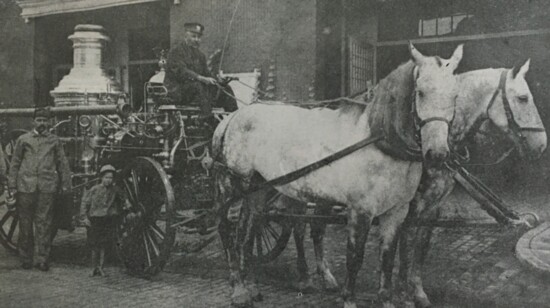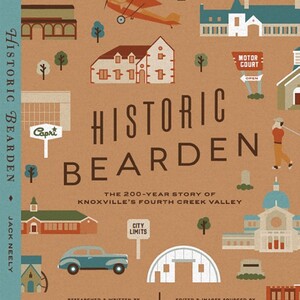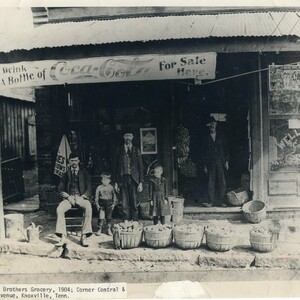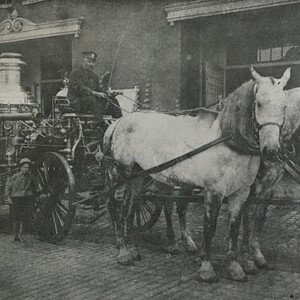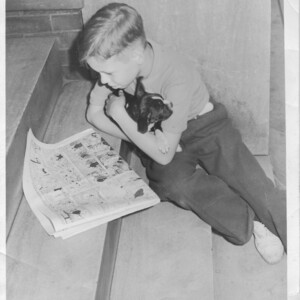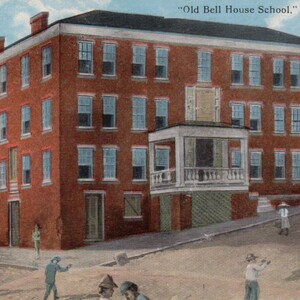We hope you enjoy this monthly sampler from Knoxville History Project’s "Knoxville Shoebox" collection. We are always on the lookout for old family and personal pictures--especially when there’s something distinctly Knoxvillian about them. Our goal is to help fill in the many gaps in the photographic record of our city’s past.
If you have interesting old photographs of your own, from any era, we’d love to hear from you. You show us the photograph, we copy it and give the original back to you. We preserve and archive the image and make it available for researchers of the future, always crediting your contribution. Sharing was never so easy—and we’ll do our best to make your images immortal!
Please contact Paul James at the Knoxville History Project at (865) 337-7723 or Paul@KnoxHistoryProject.org. Learn more at KnoxvilleHistoryProject.org/Knoxville-Shoebox
Coca-Cola
This humble grocery at 3rd and Central--near where Knoxville High School was later built--played a surprising role in East Tennessee advertising history. Coca-Cola was only available as a fountain drink before James Patrick Roddy, Sr., began bottling the soda by hand in a nearby shop in 1902. The banner, hanging from the store’s tin roof, is believed to be the first public advertisement for Coca-Cola in the area. Shared by Patrick Roddy.
Fire Hall No. 5
In Knoxville’s early days, firefighting was largely a volunteer affair in the days when available equipment included a large wooden box on wheels along with a ladder and a few axes. But by 1867, firemen were able to tackle blazes with a steam-powered fire engine, a predecessor of the one seen here at the #5 Fire Hall on Arthur Street in Mechanicsville. That fire hall, in operation since 1909, is still in use. Horses remained a central part of fire-fighting activities until around 1914 when they were finally replaced by motorized fire engines. Shared by D.J. Corcoran, City of Knoxville Fire Department.
Silver Dollar
Reader Jacki Willard shared this photograph of her father Jack as a young lad when he lived downtown in the Glencoe Apartments building on State Street during the 1930s and ‘40s. A Knoxville Journal photographer captured Jack reading the “Blondie” strip comic along with his puppy, Pete, on the apartment steps. As a result, the boy, along with several others also caught on camera, received a silver dollar. The character Blondie was also featured in a film showing nearby at the Riviera on Gay Street that same month, September 1940.
Bell House School
Jack Willard, seen in the previous photograph, went to school downtown at the Bell House School on Main Street at State Street. A brick antebellum hotel built before 1872, Bell House School was developed as Knoxville’s first public school. At that time, the idea of a free public school paid for by taxpayers was controversial. Substantially rebuilt in 1890, the school operated as an elementary school for almost a century, closing in 1967. Postcard shared by Sam Furrow.
Historic Bearden
Golf, airplanes, Rock 'n' Roll, and the Civil War - you can rarely find all those subjects in one book, but they're all part of the story of one particular part of Knoxville, and they're all in KHP’s most recent book, Historic Bearden: The 200-Year Story of Knoxville's Fourth Creek Valley. The fully illustrated book tells the stories of runaway bootleggers, mysterious millionaires, an obscure band of Cherokee, and a forgotten amusement park--with cameos by Jesse Owens, Sgt. York, Ingrid Bergman, and the Carter Family, all of whom found good reason to make public appearances in this neighborhood over the years. Available from the Knoxville History Project and local bookstores and gift shops.
ABOUT
The Knoxville History Project is an educational nonprofit with a mission to research, preserve and promote the history and culture of Knoxville. KHP gives talks and presentations (in-person and on Zoom), creates books, and engages the public online through stories, oral history conversations, driving tours and much more.
Please help us connect more Knoxvillians and visitors to the history of the city by making a donation to support the work of the Knoxville History Project at KnoxvilleHistoryProject.org/KHP-Donations.
